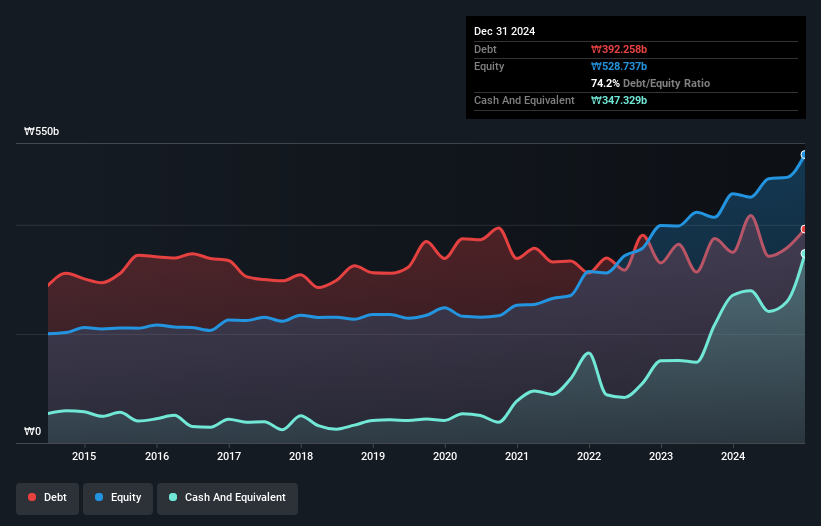- South Korea
- /
- Luxury
- /
- KOSE:A005390
Shinsung Tongsang (KRX:005390) Takes On Some Risk With Its Use Of Debt

David Iben put it well when he said, 'Volatility is not a risk we care about. What we care about is avoiding the permanent loss of capital.' So it might be obvious that you need to consider debt, when you think about how risky any given stock is, because too much debt can sink a company. We can see that Shinsung Tongsang Co., Ltd. (KRX:005390) does use debt in its business. But should shareholders be worried about its use of debt?
When Is Debt A Problem?
Debt assists a business until the business has trouble paying it off, either with new capital or with free cash flow. In the worst case scenario, a company can go bankrupt if it cannot pay its creditors. However, a more frequent (but still costly) occurrence is where a company must issue shares at bargain-basement prices, permanently diluting shareholders, just to shore up its balance sheet. Of course, debt can be an important tool in businesses, particularly capital heavy businesses. The first step when considering a company's debt levels is to consider its cash and debt together.
What Is Shinsung Tongsang's Net Debt?
You can click the graphic below for the historical numbers, but it shows that as of December 2024 Shinsung Tongsang had ₩392.3b of debt, an increase on ₩349.6b, over one year. However, because it has a cash reserve of ₩347.3b, its net debt is less, at about ₩44.9b.

A Look At Shinsung Tongsang's Liabilities
According to the last reported balance sheet, Shinsung Tongsang had liabilities of ₩487.6b due within 12 months, and liabilities of ₩265.7b due beyond 12 months. On the other hand, it had cash of ₩347.3b and ₩118.1b worth of receivables due within a year. So its liabilities outweigh the sum of its cash and (near-term) receivables by ₩287.9b.
This is a mountain of leverage relative to its market capitalization of ₩386.6b. This suggests shareholders would be heavily diluted if the company needed to shore up its balance sheet in a hurry.
Check out our latest analysis for Shinsung Tongsang
In order to size up a company's debt relative to its earnings, we calculate its net debt divided by its earnings before interest, tax, depreciation, and amortization (EBITDA) and its earnings before interest and tax (EBIT) divided by its interest expense (its interest cover). This way, we consider both the absolute quantum of the debt, as well as the interest rates paid on it.
While Shinsung Tongsang's low debt to EBITDA ratio of 0.23 suggests only modest use of debt, the fact that EBIT only covered the interest expense by 5.7 times last year does give us pause. So we'd recommend keeping a close eye on the impact financing costs are having on the business. Unfortunately, Shinsung Tongsang's EBIT flopped 16% over the last four quarters. If that sort of decline is not arrested, then the managing its debt will be harder than selling broccoli flavoured ice-cream for a premium. The balance sheet is clearly the area to focus on when you are analysing debt. But you can't view debt in total isolation; since Shinsung Tongsang will need earnings to service that debt. So when considering debt, it's definitely worth looking at the earnings trend. Click here for an interactive snapshot.
Finally, a business needs free cash flow to pay off debt; accounting profits just don't cut it. So we always check how much of that EBIT is translated into free cash flow. During the last three years, Shinsung Tongsang produced sturdy free cash flow equating to 60% of its EBIT, about what we'd expect. This free cash flow puts the company in a good position to pay down debt, when appropriate.
Our View
Shinsung Tongsang's EBIT growth rate and level of total liabilities definitely weigh on it, in our esteem. But its net debt to EBITDA tells a very different story, and suggests some resilience. When we consider all the factors discussed, it seems to us that Shinsung Tongsang is taking some risks with its use of debt. So while that leverage does boost returns on equity, we wouldn't really want to see it increase from here. Over time, share prices tend to follow earnings per share, so if you're interested in Shinsung Tongsang, you may well want to click here to check an interactive graph of its earnings per share history.
At the end of the day, it's often better to focus on companies that are free from net debt. You can access our special list of such companies (all with a track record of profit growth). It's free.
If you're looking to trade Shinsung Tongsang, open an account with the lowest-cost platform trusted by professionals, Interactive Brokers.
With clients in over 200 countries and territories, and access to 160 markets, IBKR lets you trade stocks, options, futures, forex, bonds and funds from a single integrated account.
Enjoy no hidden fees, no account minimums, and FX conversion rates as low as 0.03%, far better than what most brokers offer.
Sponsored ContentNew: Manage All Your Stock Portfolios in One Place
We've created the ultimate portfolio companion for stock investors, and it's free.
• Connect an unlimited number of Portfolios and see your total in one currency
• Be alerted to new Warning Signs or Risks via email or mobile
• Track the Fair Value of your stocks
Have feedback on this article? Concerned about the content? Get in touch with us directly. Alternatively, email editorial-team (at) simplywallst.com.
This article by Simply Wall St is general in nature. We provide commentary based on historical data and analyst forecasts only using an unbiased methodology and our articles are not intended to be financial advice. It does not constitute a recommendation to buy or sell any stock, and does not take account of your objectives, or your financial situation. We aim to bring you long-term focused analysis driven by fundamental data. Note that our analysis may not factor in the latest price-sensitive company announcements or qualitative material. Simply Wall St has no position in any stocks mentioned.
About KOSE:A005390
Shinsung Tongsang
Manufactures, distributes, and sells clothing products in South Korea and internationally.
Flawless balance sheet with proven track record.
Market Insights
Community Narratives




